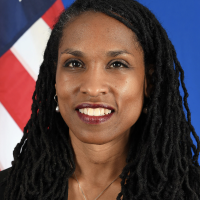Water @ Wilson | The Significance of the Coming El Niño: Understanding the Science and Preparing for Its Impacts
Submit a question
When the National Oceanic and Atmospheric Association (NOAA) declared the beginning of an El Niño event on June 8, 2023, the recurring climate pattern featured in headlines all over the world as media outlets sought to cover its anticipated impacts.
A recent Water @ Wilson event –“The Significance of the Coming El Niño: Understanding the Science and Preparing for its Impacts”—brought together experts at the Wilson Center to explain the complex science behind El Niño and explore its regional implications. The speakers also surveyed the policy tools at our disposal to prepare for its significant climate effects.
Sarah Kapnick, Chief Scientist at NOAA, unpacked what the association’s declaration of an El Niño actually means, stating that there was an “84 percent chance of it reaching moderate El Niño and a 56 percent chance of reaching strong El Niño by the winter.” She added that the NOAA’s declaration of an El Niño only refers to changes in a portion of the Pacific, however, and does not encompass regional warming scenarios elsewhere, such as along the coast of South America.
Whatever the strength of this particular El Niño event, its effects will be felt on a broad scale. In her opening remarks, Maxine Burkett, Deputy Secretary for Oceans, Fisheries, and Polar Affairs, pointed out that “the ocean, marine life, and communities that rely on both are truly bearing the brunt of climate impacts—and this year, those stresses are going to be exacerbated by the El Niño-Southern Oscillation.”
Meeting the immediate humanitarian needs of communities that will bear the brunt of El Niño is an important part of any response. But this is only part of the solution. Effectively preparing for the coming impacts will also require understanding both the social and political vulnerability of countries and regions to these sorts of ecological shocks.
What is El Niño?
Any deeper comprehension of El Niño’s effects requires a clear understanding of this climate pattern. El Niño is the warmer companion to a cooler shift in temperature known as La Niña. Together, the two phenomena create the El Niño-Southern Oscillation (ENSO)—rival climate shifts that sporadically alter the normal ocean conditions in the Pacific Ocean every two to seven years.
In the Pacific, trade winds traditionally blow east to west, taking warm surface water from the Americas towards Asia, which is replaced by deeper, nutrient-rich, and colder water along the west coast of the Americas through a process called upwelling. Yet as trade winds weaken, El Niño brings warmer ocean water east, back into the equatorial Pacific, reducing upwelling near the Americas.
The result for global climate? The presence of warmer water in the east forces the Pacific jet stream to dip south. Not only does this change have consequences for the weather in North America, but the broader shift in Pacific Ocean temperature can have varied effects around the globe.
Kapnick noted that shifting ocean temperatures also change rainfall patterns throughout the world, which can create extreme drought in some areas and flooding in others and sets up “problems for society as well as changes in agricultural productivity in different regions.”
Historically, El Niño has also led to more hurricanes in the Pacific and fewer hurricanes in the Atlantic. Yet overall climate trends may alter this pattern. Warmer global temperatures make it likely to be a “near normal” hurricane season in the Atlantic and an “above normal” season in the Pacific.
Is the World Prepared?
The question of how global warming will affect El Niño and other patterns is key to shaping responses. As ECSP Director Lauren Risi observed: “El Niño is not new, but in an era increasingly shaped by climate change, El Niño is also changing.”
And as El Niño changes, its effects on different geographic regions around the world and the communities that inhabit them change too. The capacity of social and governance structures to deal with the impacts of extreme events plays a key role in vulnerability to El Niño. Experts from Latin America, South and Southeast Asia, as well as Africa, offered insight into the vulnerability of each region to this global phenomenon.
Latin America is one example of a region in which countries lack updated early warning systems that could help mitigate El Niño’s impacts. Rodney Martinez, Representative for North America, Central America, and the Caribbean for the World Meteorological Organization, pointed out that “58 percent of South American countries” have no early warning systems, and many are plagued by political strife and poverty that hamper their “climate response capacity.”
Martinez said that the unusually strong El Niño of 1997-1998 offered a lesson in the importance of meteorological infrastructure and a more stable society. “We do not just need information,” he said, but social and political challenges in each country must also be addressed “to ensure the best response.”
South and Southeast Asia are also no strangers to the intersection of extreme weather and socio-political challenges. In El Niño years, this region has historically experienced more drought and higher average temperatures, impacting public health and agricultural yields. Yet Sarang Shidore, Director of Studies at the Quincy Institute for Responsible Statecraft, observed that while storms normally decrease in the region during El Niño, warmer ocean temperatures may generate a normal cyclone season.
Shidore also noted that while Bangladesh is among the most vulnerable countries in the region to climate change, it is also trying to prepare its defenses. The country has invested close to $10 billion in cyclone shelters, embankments, early warning systems, and evacuation plans. And through its National Adaptation Plan, he added, Bangladesh is “preparing 20 or 22 existing towns and cities to absorb the kind of migration we are going to see.”
In India, Shidore pointed to new early warning systems and well-timed evacuations that helped to reduce the number of deaths that could have been caused by the recent formation of Cyclone Biparjoy. Yet while Bangladesh and India offer positive examples of preparedness, he added that violence and instability in places like Myanmar could be exacerbated by the El Niño’s effects and spill over into its neighboring countries. (In fact, that nation’s military junta recently blocked aid to cyclone affected communities.) “There is no one single story” in the region, he observed.
Milaku Yirga, Ethiopia Country Director for Mercy Corps, stated that the same could be said for Africa. In Ethiopia, he observed, “there is a high vulnerability [to El Niño] based on recorded drought from the previous couple of years.” This state of affairs also has severely impacted the capacity of governance systems and communities in the country.
Yirga added that Ethiopia’s government, in concert with international partners, has provided aid to meet the immediate needs of people, in the form of digital early warning systems and “low-cost technology to disperse water away from areas into lowlands.” However, he lamented that this activity also takes away from long-term investment in Ethiopia’s development, which could improve the country’s overall resilience to the impacts of shocks like El Niño.
Seeking Better Responses
Experts predict that, as this El Niño progresses, it is likely to be more intense and diverge from historical trends. But Burkett says that the unpredictability of this climate pattern—especially in the context of large climate change—is part of the threat. “Because each El Niño event is unique,” she said, “it is incredibly difficult to predict the impact.” Meeting the needs of communities affected by El Niño demands that “we need to be ready to provide rapid, varied, and nuanced responses.”
Burkett pointed to the President’s Emergency Plan for Adaptation and Resilience (PREPARE) as one example of this type of response. PREPARE will allow the U.S. government to “put early warning systems and climate information in the hands of people who need it” and “build the resilience of health, water, and infrastructure systems…stressed by climate change and further stressed by El Niño.”
Other panelists echoed Burkett’s call for varied response mechanisms, including the need for more and stronger transnational partnerships, as well as the need for multilateral financial assistance. Shidore noted that “climate finance can really make a difference” for countries that have the skills but lack the financial means to prepare for the impacts of El Niño. Yet he added that climate finance mechanisms also require something that many countries lack: effective governance structures to implement funding.
Martinez observed that fashioning effective responses requires a “focus on the structural issues, otherwise, we will invest a lot of resources in several initiatives that will not get the engagement of all countries.” He concluded that “this is a matter of capacity building at the highest level and investing more in proactive risk management strategies.”
One key takeaway? El Niño will not only change weather patterns. It will also reveal the intertwined relationship between social and ecological risk. Therefore, preparing for the impacts of El Niño will require proactive policies that target the intersection between ecological and sociopolitical vulnerability.
For updated information on the progression of this El Niño, visit: Climate.gov.
Written by Angus Soderberg, edited by Richard Byrne.
Speakers
Introduction

Moderator

Hosted By

Environmental Change and Security Program
The Environmental Change and Security Program (ECSP) explores the connections between environmental change, health, and population dynamics and their links to conflict, human insecurity, and foreign policy. Read more


Africa Program
The Africa Program works to address the most critical issues facing Africa and US-Africa relations, build mutually beneficial US-Africa relations, and enhance knowledge and understanding about Africa in the United States. The Program achieves its mission through in-depth research and analyses, public discussion, working groups, and briefings that bring together policymakers, practitioners, and subject matter experts to analyze and offer practical options for tackling key challenges in Africa and in US-Africa relations. Read more


Latin America Program
The Wilson Center’s prestigious Latin America Program provides non-partisan expertise to a broad community of decision makers in the United States and Latin America on critical policy issues facing the Hemisphere. The Program provides insightful and actionable research for policymakers, private sector leaders, journalists, and public intellectuals in the United States and Latin America. To bridge the gap between scholarship and policy action, it fosters new inquiry, sponsors high-level public and private meetings among multiple stakeholders, and explores policy options to improve outcomes for citizens throughout the Americas. Drawing on the Wilson Center’s strength as the nation’s key non-partisan policy forum, the Program serves as a trusted source of analysis and a vital point of contact between the worlds of scholarship and action. Read more


Mexico Institute
The Mexico Institute seeks to improve understanding, communication, and cooperation between Mexico and the United States by promoting original research, encouraging public discussion, and proposing policy options for enhancing the bilateral relationship. A binational Advisory Board, chaired by Luis Téllez and Earl Anthony Wayne, oversees the work of the Mexico Institute. Read more


Polar Institute
Since its inception in 2017, the Polar Institute has become a premier forum for discussion and policy analysis of Arctic and Antarctic issues, and is known in Washington, DC and elsewhere as the Arctic Public Square. The Institute holistically studies the central policy issues facing these regions—with an emphasis on Arctic governance, climate change, economic development, scientific research, security, and Indigenous communities—and communicates trusted analysis to policymakers and other stakeholders. Read more

